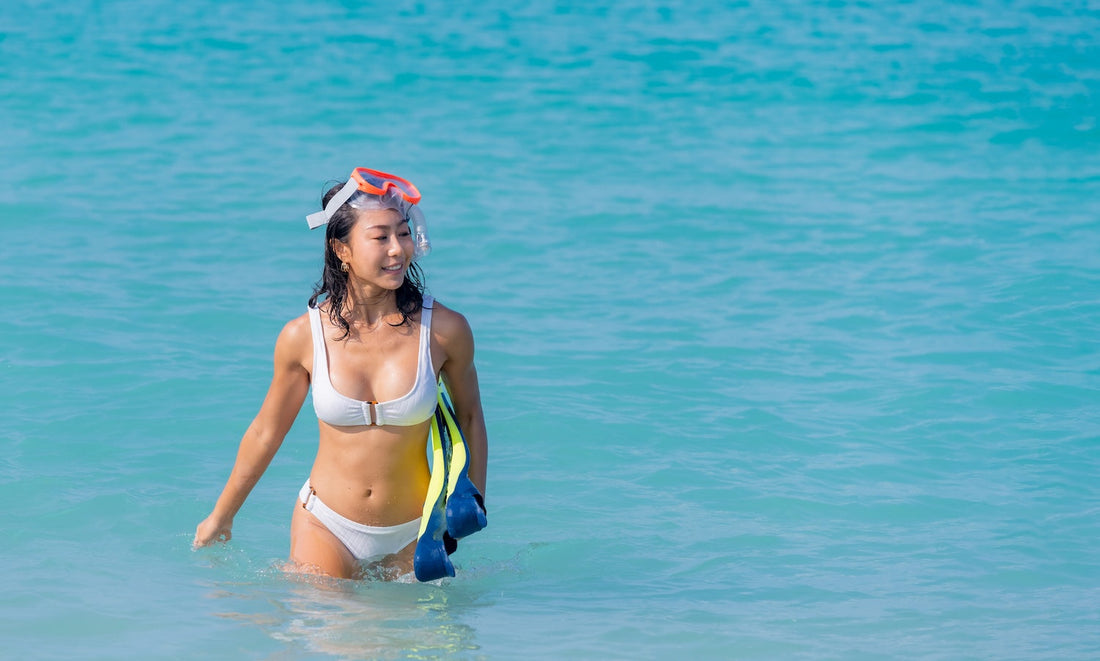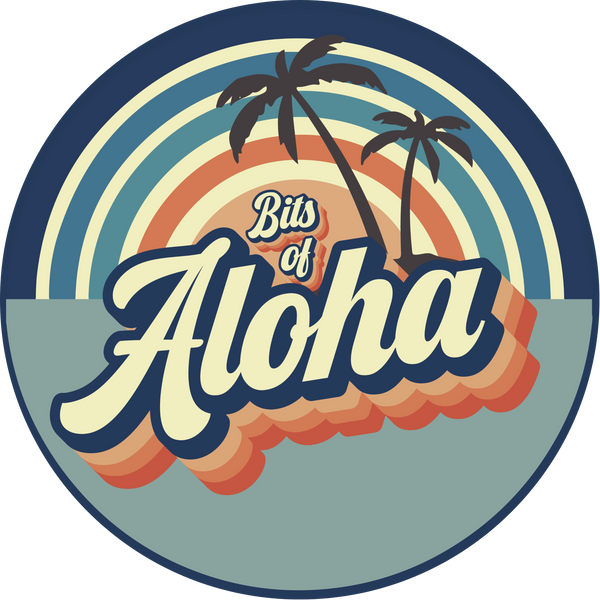
The Bikini’s Journey to Hawaiʻi: From Paris to Paradise
Share
The Creation of the Bikini—and How It Became Iconic in Hawaiʻi
When you picture a Hawaiian beach, you probably imagine turquoise water, golden sand, and a bikini-clad surfer paddling toward the waves. The bikini is so deeply woven into Hawaiʻi’s identity that it’s hard to imagine island life without it. Yet, like many fashion revolutions, the bikini was born half a world away—in postwar Paris, not Waikīkī.
Its arrival in Hawaiʻi marked a cultural shift that blended surf, sun, and freedom with fashion innovation. Here’s how the bikini went from a shocking French invention to a defining symbol of Hawaiian beach culture and global resort style.
From Bombshell to Breakthrough: The Invention of the Bikini
The modern bikini was introduced in 1946, designed by Louis Réard, a French engineer turned swimwear designer. He named it after Bikini Atoll, a remote Pacific island where the U.S. was conducting atomic bomb tests—suggesting his design would be equally explosive.
Réard’s bikini was made of just 30 inches of fabric, cut into four triangles connected by string. It was bold, minimalist, and scandalous. French model Micheline Bernardini debuted it at a Paris fashion show on July 5, 1946, after no professional model dared to wear it.
While two-piece swimsuits existed before—especially in Hollywood films of the 1930s and 1940s—the bikini represented a daring new idea: the liberation of the female body.
But in conservative postwar America, the bikini was initially banned on many beaches and denounced by religious groups. It would take another decade for the world—and Hawaiʻi—to embrace it.
The 1950s: Hawaiʻi Becomes America’s Playground
After World War II, Hawaiʻi transformed from a strategic military outpost to a tropical dreamscape for returning soldiers and curious tourists. By the time statehood arrived in 1959, the islands were booming with hotels, surf clubs, and a new generation of free-spirited youth.
At this moment, Hollywood discovered Hawaiʻi—and with it, the bikini.
- Elvis Presley’s “Blue Hawaii” (1961) showed sun-kissed women in bright two-pieces dancing on Waikīkī Beach.
- Gidget Goes Hawaiian (1961) helped define the surf-girl archetype, featuring teen stars in playful bikinis and flower leis.
- Magazine photo shoots and postcards showcased hula girls in bikini tops and pareo wraps, linking the look with the islands’ carefree allure.
Tourism boomed, surfboards got shorter, and bikinis became the unofficial uniform of the beach.
Surf Culture and the Rise of the Hawaiian Bikini
By the early 1960s, Hawaiʻi was at the center of a global surf explosion, led by pioneers like Duke Kahanamoku’s protégés and California transplants who migrated to the North Shore in search of the perfect wave.
In this environment, the bikini evolved from a fashion statement to functional surfwear.
Early Hawaiian Bikini Designers
Local designers began adapting the European bikini to suit the active, wave-loving lifestyle of island women:
- Reyn’s of Hawaiʻi and Hilo Hattie, known for aloha shirts, experimented with matching bikini sets in tropical prints.
- Boutique designers in Waikīkī and Kailua started sewing custom suits for surfers, using durable fabrics like stretch nylon and elasticized cotton.
- By the late 1960s, local surf brands like Hang Ten and Surf Line Hawaiʻi incorporated bikinis into their collections.
The Hawaiian bikini was born—not just as a fashion item but as an expression of island independence and athletic grace.
How the Bikini Reflected Hawaiʻi’s Cultural Shift
The bikini’s rise in Hawaiʻi wasn’t just about style—it reflected a changing cultural identity.
1. From Modesty to Mobility
Before the bikini, women wore one-piece suits or wraps that restricted movement. As surfing and swimming became mainstream, bikinis offered freedom and function, empowering women to move, paddle, and sunbathe comfortably.
2. Tourism and Modernization
As Hawaiʻi became a top U.S. tourist destination, the bikini became an emblem of modern, tropical femininity. Photos of bikini-clad visitors lounging under palm trees became visual shorthand for “paradise.”
3. The Aloha Aesthetic
Designers embraced Hawaiian prints, hibiscus patterns, and bright colors. The bikini became not only a fashion statement but a wearable souvenir of aloha—a fusion of Western fashion and island culture.
The 1970s–1980s: The Golden Age of Hawaiian Swimwear
The 1970s marked the golden age of Hawaiʻi’s bikini industry. New fabrics like Lycra and spandex allowed for better fit and flexibility. Local surfwear companies like HIC (Hawaiian Island Creations) and Local Motion rose to prominence, designing swimwear that reflected both athletic performance and tropical beauty.
- High-Cut Styles: The late 1970s introduced high-cut legs and string-tie bikinis.
- Hawaiian Prints: Designers used hibiscus, monstera, and ti leaf motifs, emphasizing natural beauty.
- Surf Competitions: Women surfers like Rell Sunn—the “Queen of Makaha”—helped normalize bikinis as serious surf gear rather than mere beachwear.
By the 1980s, the bikini was no longer controversial—it was essential Hawaiian fashion.
The Bikini in Popular Media: Hawaiʻi Goes Global
Movies, television, and magazines cemented Hawaiʻi’s reputation as the world’s bikini capital.
- Sports Illustrated Swimsuit Edition frequently shot in Maui and Oʻahu.
- TV shows like Magnum P.I. and Baywatch: Hawaiʻi showcased the islands as a glamorous backdrop for beach fashion.
- Local designers gained international exposure as visitors brought home bikinis from Waikīkī boutiques.
At the same time, Hawaiian swimwear began influencing global trends. The “island look”—floral prints, tropical color palettes, and effortless cuts—became synonymous with resort luxury.
Modern Hawaiʻi: Sustainability and Cultural Revival
Today, the bikini remains a cornerstone of Hawaiʻi fashion, but the focus has shifted toward sustainability, cultural respect, and local craftsmanship.
- Local Designers: Brands like Acacia Swimwear, San Lorenzo Bikinis, and Issa de’ mar—all founded in Hawaiʻi—have built global followings for their designs inspired by local landscapes and surf culture.
- Eco-Friendly Materials: Recycled nylon, ocean plastics, and biodegradable fabrics are now central to modern Hawaiian swimwear.
- Body Positivity: Modern Hawaiian bikini brands embrace all body types, reflecting a cultural value of pono (balance and respect) rather than perfection.
At the same time, designers acknowledge the deep connection between Hawaiian identity and the ocean. Many incorporate traditional Hawaiian motifs, use Hawaiian names for collections, and collaborate with Native Hawaiian artists to ensure authenticity.
Why Hawaiʻi and the Bikini Endure
Few places on Earth embody the bikini’s spirit more than Hawaiʻi. The islands’ year-round sun, surf, and multicultural fashion scene have kept the bikini evolving—from retro halter styles to minimalist surf suits.
But beyond style, the bikini in Hawaiʻi represents something deeper:
- Freedom of expression and movement.
- Connection to the ocean.
- Celebration of natural beauty.
Just as Kamehameha’s feather cloaks symbolized power and prestige, the bikini in modern Hawaiʻi symbolizes confidence and cultural synthesis—where ancient reverence for nature meets contemporary self-expression.
Final Thoughts
From its scandalous debut in 1946 Paris to its embrace on Hawaiian shores in the 1950s and its dominance in surf fashion today, the bikini’s journey reflects a powerful story of liberation, adaptation, and island style.
In Hawaiʻi, the bikini evolved into more than swimwear—it became an emblem of aloha spirit, resilience, and respect for the ocean. Whether worn by surfers at Pipeline, sunbathers at Waikīkī, or global travelers chasing paradise, the bikini continues to tell Hawaiʻi’s story of beauty, empowerment, and freedom—one wave at a time.
